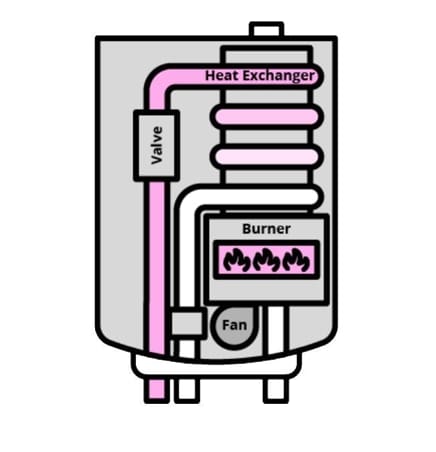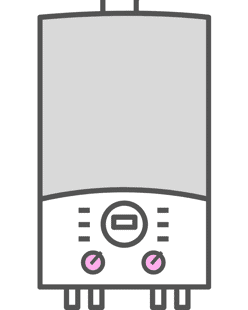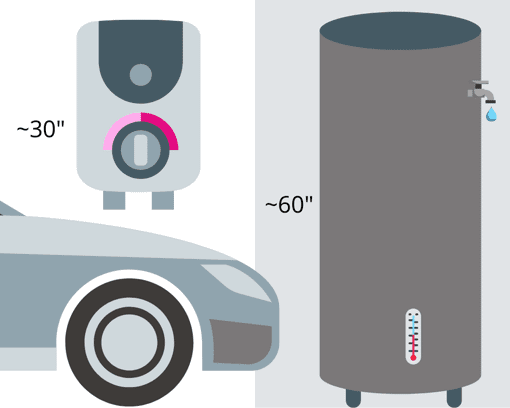
Everything You Need to Know About Tankless Water Heaters
A tankless water heater [1] is a compact unit that mounts on a wall on the inside (and sometimes outside) of the house and supplies endless, on-demand hot water to your home. These water heaters save energy (and money) because they heat water as it is needed, whereas standard hot water heaters heat and reheat water 24 hours a day.
How do Tankless Water Heaters Work?
Once a hot water faucet is turned on, cold water enters the tankless system. The burners ignite and the cold water is heated in the heat exchanger. The hot water then flows to the faucet or appliance.
When the faucet or appliance is turned off, the tankless water heater goes into standby mode.
Tankless water heaters work on-demand by using sensors and a computer board to detect the demand for hot water in the home and adjust the rate of firing, supplying just the right amount. This way, they burn less gas if you are only running one faucet at a time. You are only burning the exact amount of fuel needed, which means savings!
Types of Tankless Water Heaters
There are three types of tankless water heaters:
- Electric
- Natural Gas
- Propane
Electric tankless water heaters, although still better than a standard (tank) water heater, rarely have the capacity to serve multiple fixtures (faucets and appliances) with a single unit. For this reason, most builders do not use electric tankless water heaters and prefer gas.
When choosing the right option for your home, you’ll need to consider several factors – including which type is best for you. Because electric models are generally limited in the amount of hot water they can supply, high-demand households should opt for a gas or propane option.
Tankless Water Heaters & The Environment

Tankless heaters are beneficial for many reasons. If you’re considering one, you’ve probably wondered if they are, in fact, the “green” alternative to traditional, tank water heaters. While there are many factors that will influence the ecological impact of your water heater system, here are a few things that make tankless heaters more earth-friendly:
- Less energy waste. Because tankless water heaters are on-demand, they don’t produce hot water (and keep it heated) until you need it. This decreases overall energy usage.
- Longer lifespan. Not only do tankless models produce less energy, but they produce less waste by lasting up to 10 years longer than their tank counterparts.
Are tankless water heaters instantaneous?
No, not exactly. Some homeowners misunderstand “on-demand” to mean “instantaneous”. It takes a tankless water heater about 2 seconds to go from “standby” to producing hot water at the requested temperature.
The time it actually takes hot water to reach the faucet, “lag time”, depends on the size of the home and length of pipe between points A and B. In larger homes with low-flow fixtures installed it could take up to 3 minutes to deliver hot water if the fixture is far from the water heater.
So, technically speaking, tankless water heaters are not instantaneous but do supply hot water quickly.
Does a tankless water heater save space?

Yes! A standard tank heater installed in a garage requires a floor stand, a pipe, or another object to protect against vehicle impact (and usually venting all the way to the roof). In two-story homes, they require more framing.
While both tank and tankless models come in many sizes, it’s not uncommon to see tanked water heaters stand roughly 60 tall, and tankless models to be about half that size, if not smaller.
A tankless water heater is wall-mounted and can be vented through a sidewall and it doesn’t take up any garage floor space. Some tankless water heaters are placed in a central crawl space, near the master bath or near the kitchen to cut down on lag time.
Sometimes, a tankless will even be installed in the attic to save space. Since there’s no tank that could burst, it’s not as risky as installing a tank in the attic. Tank heaters usually have an emergency drain pan, but a three-inch deep-pan doesn’t do much if the bottom of a 50+ gallon tank bursts!
Do tankless water heaters save money?
Yes! Tankless water heaters save energy (and money) because they do not have to keep a supply of hot water ready to go. The majority of the time, a tankless is “off” or in standby mode.
A tank heater constantly fires on and off to keep the water in its tank ready for use. Another reason tankless water heaters are energy-efficient is that they are “fully modulating”. A tankless heater, on the other hand, only uses the fuel needed to heat the water requested at that time to the set point.
Additionally, the amount of energy used depends on what you’re using the hot water for. A tankless water heater will use less fuel if you are washing your hands versus filling up a bathtub.
It’s actually common for homeowners to see up to a 50% reduction in fuel use when switching to a tankless water heater!
Does a tankless water heater really supply endless hot water?
Yes! No more shower schedules or scalding your loved one when you flush the toilet. A standard bathtub holds 35 gallons, but more popular tubs these days can hold 45 gallons or even up to 80! A tank heater may not even fill that up, and if it did, there would be some recovery time before anyone else could use hot water.
If you have chosen the right capacity for your home (max flow rank) a tankless water heater could fill up all of your tubs, then handle back-to-back showers, the dishwasher, and the laundry.
Tankless Water Heater Disadvantages
Tankless water heaters tend to be more expensive than traditional, tanked heaters. However, they have a longer lifespan and can save on energy costs over time. In the long run, tankless heaters can be a good investment, financially, despite the higher costs upfront.
Tankless Water Heater Buying Guide
Investing in a new water heater can be exciting – and overwhelming. If you’d like to pursue a tankless water heater, here are a few factors to consider while narrowing down your options:
-
Calculate the amount of water you’ll need to use. You can do this by adding up the maximum flow rate (gallons per minute) of all the faucets and appliances that may use water simultaneously in your home. If you have low-flow fixtures, you may not need to heat as much water at one time.
-
Calculate the temperature rise. In short, you’ll need to calculate how much hotter the water will need to be than your “tap temperature” water. Most hot water uses require a temperature of 105 to 115 degrees. If your tap water is typically around 70 degrees because you live in a warmer climate, the difference in temperature will be less.
-
Talk to a professional. When in doubt, speak with a plumbing professional to determine the best possible model for your household needs. You’ll get to enjoy the benefits of a tankless water heater the most if you choose the right one!
Tankless Water Heater Services in San Diego, California
The pros at Anderson Plumbing, Heating & Air [2] can help! Call us today at (866) 374-0402 to request an appointment and learn more about our various plumbing services! Also, emergency service is available 24/7, 365 days a year.